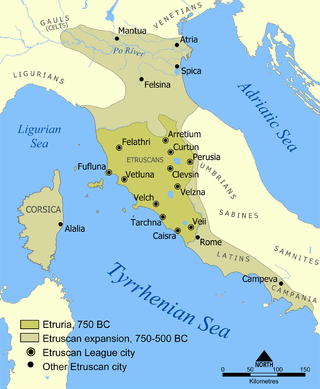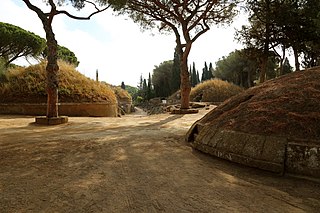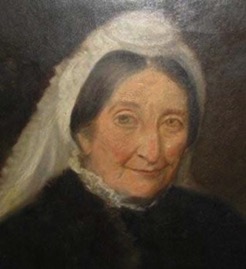Related Research Articles

Etruscan was the language of the Etruscan civilization in the ancient region of Etruria, in Etruria Padana and Etruria Campana in what is now Italy. Etruscan influenced Latin but was eventually completely superseded by it. The Etruscans left around 13,000 inscriptions that have been found so far, only a small minority of which are of significant length; some bilingual inscriptions with texts also in Latin, Greek, or Phoenician; and a few dozen purported loanwords. Attested from 700 BC to AD 50, the relation of Etruscan to other languages has been a source of long-running speculation and study, with it mostly being referred to as one of the Tyrsenian languages, at times as an isolate, and a number of other less well-known hypotheses.

The Etruscan civilization was an ancient civilization created by the Etruscans, a people who inhabited Etruria in ancient Italy, with a common language and culture who formed a federation of city-states. After conquering adjacent lands, its territory covered, at its greatest extent, roughly what is now Tuscany, western Umbria, and northern Lazio, as well as what are now the Po Valley, Emilia-Romagna, south-eastern Lombardy, southern Veneto, and western Campania.

Etruscan religion comprises a set of stories, beliefs, and religious practices of the Etruscan civilization, heavily influenced by the mythology of ancient Greece, and sharing similarities with concurrent Roman mythology and religion. As the Etruscan civilization was gradually assimilated into the Roman Republic from the 4th century BC, the Etruscan religion and mythology were partially incorporated into ancient Roman culture, following the Roman tendency to absorb some of the local gods and customs of conquered lands. The first attestations of an Etruscan religion can be traced back to the Villanovan culture.

Turan was the Etruscan goddess of love, fertility and vitality and patroness of the city of Velch.

Cerveteri is a comune (municipality) in the Metropolitan City of Rome Capital, in the Italian region of Lazio. Known by the ancient Romans as Caere, and previously by the Etruscans as Caisra or Cisra, and as Agylla by the Greeks, its modern name derives from Caere Vetus used in the 13th century to distinguish it from Caere Novum.

Uni is the ancient goddess of marriage, fertility, family, and women in Etruscan religion and myth, and was the patron goddess of Perugia. She is identified as the Etruscan equivalent of Juno in Roman mythology, and Hera in Greek mythology. As the supreme goddess of the Etruscan pantheon, she is part of the Etruscan trinity, an original precursor to the Capitoline Triad, made up of her husband Tinia, the god of the sky, and daughter Menrva, the goddess of wisdom.
Lammert Bouke van der Meer is a Dutch classicist and classical archaeologist specialized in Etruscology. He studied classics and archaeology at the University of Groningen, and received his Ph.D. from the same university in 1978 with a dissertation entitled Etruscan urns from Volterra. Studies on mythological representations, I-II. Van der Meer is retired associate professor of Classical Archaeology at Leiden University.

Etruscan cities were a group of ancient settlements that shared a common Etruscan language and culture, even though they were independent city-states. They flourished over a large part of the northern half of Italy starting from the Iron Age, and in some cases reached a substantial level of wealth and power. They were eventually assimilated first by Italics in the south, then by Celts in the north and finally in Etruria itself by the growing Roman Republic.

Etruscan art was produced by the Etruscan civilization in central Italy between the 10th and 1st centuries BC. From around 750 BC it was heavily influenced by Greek art, which was imported by the Etruscans, but always retained distinct characteristics. Particularly strong in this tradition were figurative sculpture in terracotta, wall-painting and metalworking especially in bronze. Jewellery and engraved gems of high quality were produced.
Larissa Bonfante was an Italian-American classicist, Professor of Classics emerita at New York University and an authority on Etruscan language and culture.

Usil is the Etruscan god of the sun, shown to be identified with Apulu (Apollo). His iconic depiction features Usil rising out of the sea, with a fireball in either outstretched hand, on an engraved Etruscan bronze mirror in late Archaic style, formerly on the Roman antiquities market. On Etruscan mirrors in the Classical style, Usil appears with an aureole.
Corpus Speculorum Etruscorum is an international project with the goal to publish all existing Etruscan bronze mirrors. The first three volumes were published in 1981. A total of thirty-six fascicles has been produced.

The Pontic Group is a sub-style of Etruscan black-figure vase painting.

The Sarcophagus of Seianti Hanunia Tlesnasa is the life-size sarcophagus of an Etruscan noblewoman dating from between 150–140 BC. It was acquired by the British Museum in 1887.

In ancient Italy, the Etruscan "Lega dei popoli" was a league comprising several towns — usually, but not necessarily, twelve — located in the areas that today are known as Tuscany, western Umbria and northern Lazio.
Sybille Edith Haynes, is a British expert on Etruscology. She grew up and was educated in Germany and Austria before moving to the UK in the 1950s. She worked with Etruscan artefacts at the British Museum for many years as well as publishing numerous books, for fellow scholars and also for the general public. In the 1980s she joined the Centre for the Study of Greek and Roman Antiquity at Corpus Christi College, Oxford.

Elizabeth Caroline Hamilton Gray was a Scottish historian and travel author, born in Alva, Clackmannanshire, as the eldest daughter of James Raymond Johnstone and Mary Elizabeth Cholmeley. She was the granddaughter of the colonial businessman John Johnstone.

Women were respected in Etruscan society compared to their ancient Greek and Roman counterparts. Today only the status of aristocratic women is known because no documentation survives about women in other social classes.

The Sarcophagus of Laris Pulenas, also known as "The Magistrate," dates from the 2nd or 3rd century BCE. It was discovered in Tarquinia in Italy and is now in the Tarquinia National Museum. It features a reclining figure, Laris Pulenas, before whom is a stone carving of a long strip of cloth (volumen), half-unrolled, inscribed with one of the longer continuous inscriptions in Etruscan, nearly 60 words, making it of particular linguistic value.
References
- 1 2 "Judith Swaddling". British Museum. Retrieved 3 March 2018.
- ↑ Turfa, Jean MacIntosh (January 2005). "Review of: Seianti Hanunia Tlesnasa. The Story of an Etruscan Noblewoman. The British Museum Occasional Paper Number 100". Bryn Mawr Classical Review. ISSN 1055-7660.
- ↑ Why, Who, What (12 August 2016). "Who was Leonidas of Rhodes?". BBC News. Retrieved 3 March 2018.
{{cite news}}: CS1 maint: multiple names: authors list (link) - ↑ "Judith Swaddling - Photos from the making of the Olympia Ballad - Olympia, The Ballads of the Games - BBC Radio 2". BBC. Retrieved 3 March 2018.
- ↑ Kyle, Donald G. (5 June 2016). "The Ancient Olympic Games by Judith Swaddling (review)". Journal of Sport History. 43 (1): 143–144. doi:10.5406/jsporthistory.43.1.143. ISSN 0094-1700.
- ↑ "Fellows Directory - Society of Antiquaries". www.sal.org.uk. Retrieved 3 March 2018.
- ↑ Swaddling, Judith (1993). Corpus Speculorum Etruscorum: The British Museum Fascicule I, Archaic and classical mirrors (early tanged & related mirrors). British Museum Press. ISBN 9780714112770.
- ↑ "Sybille Haynes Fund for Etruscan and Early Italic Studies" (PDF). Oxford University. Retrieved 3 March 2018.
- ↑ BBC. "BBC - Radio 4 Woman's Hour -Treasures of the British Museum - Etruscan Tomb". www.bbc.co.uk. Retrieved 4 July 2018.
- ↑ "Olympia, The Ballads of the Games - BBC Radio 2". BBC. Retrieved 4 July 2018.
- ↑ Perry, Jonathan (2009). "Review of: The Ancient Olympic Games (2nd ed., revised and updated)". Bryn Mawr Classical Review. ISSN 1055-7660.